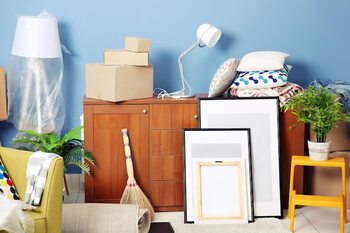Become an expert in labeling for your move.

Become an expert in labeling for your move and transform chaos into order. Good labeling not only facilitates organization but also saves time and reduces stress during the moving process. Learning to label your boxes correctly will allow you to find what you need when you need it, making your new house a home faster. Discover how to become a labeling master with our practical and helpful tips.
The importance of labeling in a successful move
Proper labeling of boxes is essential for a successful move. By assigning specific labels to each box, you can sort your belongings logically and efficiently, which not only facilitates the loading and unloading process but also helps you quickly identify the contents of each box. For example, by labeling boxes with keywords like "kitchen," "bathroom," or "clothes," you can direct helpers or movers to the correct areas of your new home without wasting time searching through each box. This organization prevents frustration and ensures that all items arrive at their appropriate destination.
Additionally, a good labeling system can be an invaluable tool during the unpacking process. Imagine arriving at your new home and finding everything in its place thanks to your well-thought-out labels; this will not only save you time but also minimize the stress associated with moving. Consider also including additional information on the labels, such as special instructions or a color code for different rooms. By doing so, you become the master of labeling and transform what could be a messy chaos into a smooth and organized experience.
2. Necessary materials for effective labeling
To achieve effective labeling during your move, it is crucial to have the right materials. Start by choosing a type of label that suits your needs; you can opt for self-adhesive labels, which are easy to apply and can be printed or written by hand. You might also consider using colored tape or permanent markers, which will allow you to create a visual coding system that facilitates quick identification of the contents of each box. Remember that the labels should be sturdy enough to withstand transport and handling, so make sure to select durable materials.
In addition to the labels, you will need to consider other tools such as scissors, tape, and a permanent marker. The scissors will be useful for cutting any additional materials you need for your labels, while the tape can help you secure the labels in place. A permanent marker is essential not only for writing the contents of each box but also for noting special instructions or warnings about fragile items. With these materials on hand, you will be ready to organize your move efficiently and without complications.
3. Color strategies to organize your boxes
One of the most effective strategies for organizing your boxes during a move is to use a color-coding system. Assigning a specific color to each room or type of item will not only make the labeling process more visual but also facilitate quick identification when it comes time to unload and unpack. For example, you can use red labels for the kitchen, blue for the bedroom, and green for the living room. This technique will allow you to see at a glance which box belongs to each area without needing to read each label in detail, saving time and reducing initial clutter.
In addition to the color system, consider combining it with symbols or icons that represent the contents of the boxes. This can be especially useful if you have many boxes of the same color; for example, you can include a small drawing or an icon on the label indicating whether it contains utensils, clothing, or books. This way, when you arrive at your new home, you will be able to quickly identify which box to open first based on your immediate needs. By implementing these visual strategies in your labeling, you will transform your move into a much more organized and less stressful experience.
4. How to create a numbering system for greater clarity
To achieve an efficient move, establishing a numbering system for your boxes can be essential. Start by assigning a number to each box and noting down a list of what each one contains. For example, box 1 may contain kitchen utensils, while box 2 may be dedicated to seasonal clothing. This classification will not only help you quickly identify the contents of each box, but it will also make locating them easier when you arrive at your new home. By having a clear and organized record, you will avoid opening multiple boxes searching for that specific item.
Additionally, consider including a color coding system in your numbering. Use different colored labels to represent specific rooms: for example, blue for the kitchen, red for the bedroom, and green for the living room. This visual method will complement your numbered list and allow you to quickly distinguish which box belongs to which area when unloading. Remember to place the labels in visible and readable spots; this way, you can find everything more easily when organizing your new home. A good system not only provides clarity but also transforms an overwhelming task into something more manageable and less stressful.
5. Labels: manually or printed? Pros and cons
Labeling your boxes during a move can be done in two ways: manually or with printed labels, and each method has its pros and cons. Manual labels, which you can make with markers and paper, are quick and inexpensive; you can customize them instantly based on your needs. However, this approach may lead to inconsistencies in legibility and design, which could make it difficult to quickly identify contents in hurried moments. Additionally, if the text smudges or gets dirty during transport, you might find yourself searching through several boxes before finding what you really need. On the other hand, printed labels offer a more professional and uniform appearance, making them easier to read at a glance. You can design them with specific software to include additional information such as special handling instructions or the final destination within your new home. Despite their visual clarity, this method requires more initial time to set up and print. There is also a cost associated if you choose to use adhesive paper or printing services. Consider your specific needs and the time available when deciding which option is best for you; the important thing is that it helps reduce stress during your transition to a new home!
6. The essential vs. the dispensable: how to prioritize labels
When approaching the labeling process for your move, it is crucial to distinguish between the essential and the dispensable. Start by identifying the items you really need in your new home and those that can wait to be unpacked. For example, everyday items like clothing, kitchen utensils, and personal hygiene products should be clearly labeled and accessible. In contrast, decorative objects or tools that are not used frequently can go in lower-priority boxes. This classification will help you determine which labels are fundamental for efficient unpacking, avoiding frustration in the days following the move.
Once you have identified the essentials, you can apply a color system or symbols to your labels to further facilitate organization. Assign a specific color for the essential boxes and another for the non-essential ones; this way, upon arriving at your new home, you can direct your efforts towards the most important items without wasting time searching through less relevant boxes. This approach not only simplifies the initial unpacking but also allows you to enjoy a smoother transition to your new space, focusing on making your new house a cozy place from day one.
7. Tips for labeling appliances and large furniture
Labeling appliances and large furniture may seem like an overwhelming task, but with some practical tips, you can do it effectively. Start by identifying each item with a clear label that includes its name and the room it belongs to in your new home. Use different colored adhesive labels for each room; for example, blue for the kitchen and green for the living room. This will not only make it easier to distinguish them at a glance, but it will also help the movers place them in the correct spot without confusion.
In addition to the visible labels, consider taking photos of each appliance or piece of furniture before disassembling or moving it. These images will serve as a reference during the unpacking process and will help you remember how they originally looked in place. If you have important instructions or manuals, be sure to keep them in a labeled envelope and place this envelope next to the corresponding appliance. This way, you will have everything you need on hand when it’s time to install your equipment in your new home.
8. Maintaining control: inventory lists alongside labeling
Maintaining control during a move is essential to ensure that each item arrives at its destination without complications. An effective way to achieve this is by creating inventory lists that accompany each labeled box. By listing the items inside each container, you will have a clear overview of what you own and where it is located. This practice will not only help you verify that nothing is left behind, but it will also facilitate the unpacking process in your new home, allowing you to quickly locate the essential items.
Labeling and inventory lists go hand in hand to provide you with an organized and stress-free system. Make sure to include important details on your labels, such as the contents of the box and the room it belongs to. Additionally, if you use specific colors or codes, you will be able to quickly visually identify related boxes. With this methodical approach, you will transform your moving experience into a smooth and efficient process, allowing you to enjoy the exciting transition to your new home more.
9. Post-move tips: how to adjust your labeling system in your new home
Once you have moved in and all the boxes are in place, it is the perfect time to adjust your labeling system and adapt it to your new home. Start by reviewing each label and ensuring that the information is accurate and relevant to the current layout of your spaces. Some items may have changed places, or you may have decided to organize your rooms differently. Take the necessary time to re-label the boxes if needed, as well as to implement a color-coding system or an alphabetical system that better suits your daily needs.
Additionally, consider keeping a digital or physical inventory of the contents of each box. This will not only make it easier to find specific items but also help you identify which objects can be discarded or donated over time. Continuous organization is key to maintaining order in your new home; therefore, establish a designated space where you can store extra labels and office supplies. This way, when you acquire new items or make changes to the layout, you can quickly label without losing the efficiency achieved during your initial move.



